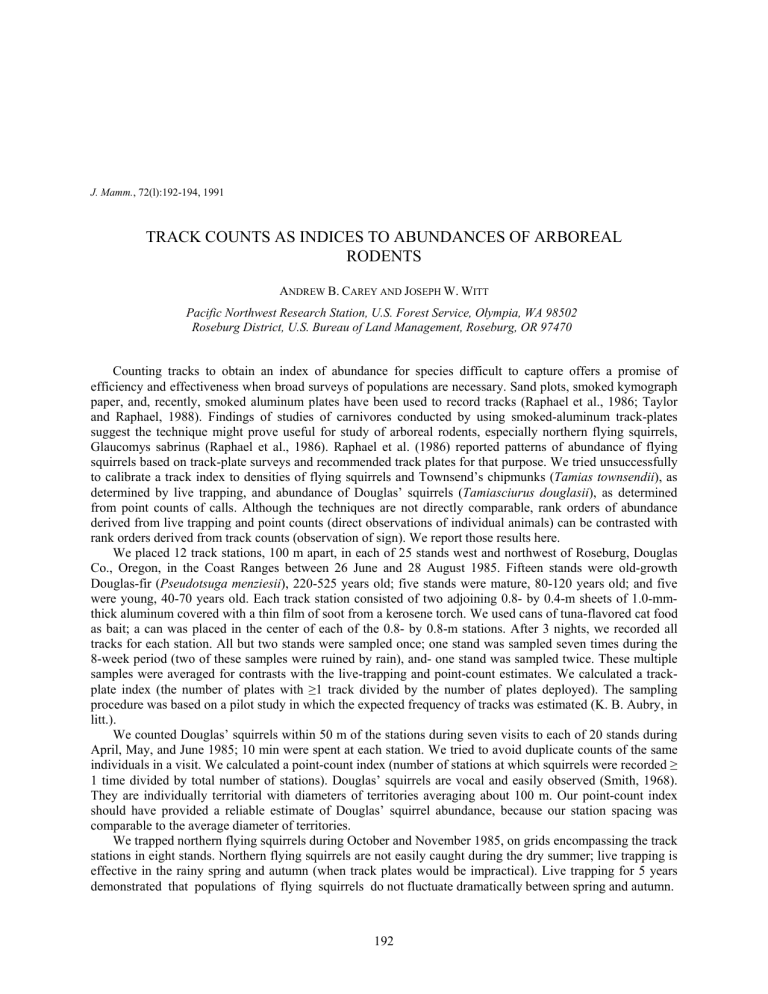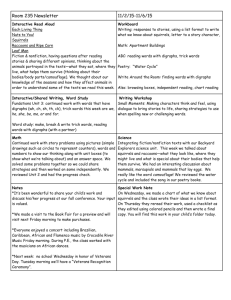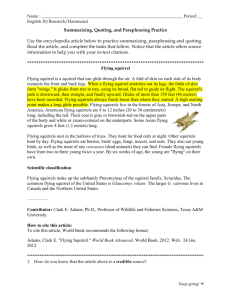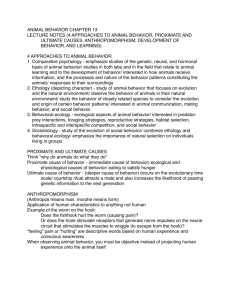TRACK COUNTS AS INDICES TO ABUNDANCES OF ARBOREAL RODENTS

J. Mamm.
, 72(l):192-194, 1991
TRACK COUNTS AS INDICES TO ABUNDANCES OF ARBOREAL
RODENTS
A NDREW B.
C AREY AND J OSEPH W.
W ITT
Pacific Northwest Research Station, U.S. Forest Service, Olympia, WA 98502
Roseburg District, U.S. Bureau of Land Management, Roseburg, OR 97470
Counting tracks to obtain an index of abundance for species difficult to capture offers a promise of efficiency and effectiveness when broad surveys of populations are necessary. Sand plots, smoked kymograph paper, and, recently, smoked aluminum plates have been used to record tracks (Raphael et al., 1986; Taylor and Raphael, 1988). Findings of studies of carnivores conducted by using smoked-aluminum track-plates suggest the technique might prove useful for study of arboreal rodents, especially northern flying squirrels,
Glaucomys sabrinus (Raphael et al., 1986). Raphael et al. (1986) reported patterns of abundance of flying squirrels based on track-plate surveys and recommended track plates for that purpose. We tried unsuccessfully to calibrate a track index to densities of flying squirrels and Townsend’s chipmunks ( Tamias townsendii ), as determined by live trapping, and abundance of Douglas’ squirrels ( Tamiasciurus douglasii ), as determined from point counts of calls. Although the techniques are not directly comparable, rank orders of abundance derived from live trapping and point counts (direct observations of individual animals) can be contrasted with rank orders derived from track counts (observation of sign). We report those results here.
We placed 12 track stations, 100 m apart, in each of 25 stands west and northwest of Roseburg, Douglas
Co., Oregon, in the Coast Ranges between 26 June and 28 August 1985. Fifteen stands were old-growth
Douglas-fir ( Pseudotsuga menziesii ), 220-525 years old; five stands were mature, 80-120 years old; and five were young, 40-70 years old. Each track station consisted of two adjoining 0.8- by 0.4-m sheets of 1.0-mmthick aluminum covered with a thin film of soot from a kerosene torch. We used cans of tuna-flavored cat food as bait; a can was placed in the center of each of the 0.8- by 0.8-m stations. After 3 nights, we recorded all tracks for each station. All but two stands were sampled once; one stand was sampled seven times during the
8-week period (two of these samples were ruined by rain), and- one stand was sampled twice. These multiple samples were averaged for contrasts with the live-trapping and point-count estimates. We calculated a trackplate index (the number of plates with ≥ 1 track divided by the number of plates deployed). The sampling procedure was based on a pilot study in which the expected frequency of tracks was estimated (K. B. Aubry, in litt.).
We counted Douglas’ squirrels within 50 m of the stations during seven visits to each of 20 stands during
April, May, and June 1985; 10 min were spent at each station. We tried to avoid duplicate counts of the same individuals in a visit. We calculated a point-count index (number of stations at which squirrels were recorded ≥
1 time divided by total number of stations). Douglas’ squirrels are vocal and easily observed (Smith, 1968).
They are individually territorial with diameters of territories averaging about 100 m. Our point-count index should have provided a reliable estimate of Douglas’ squirrel abundance, because our station spacing was comparable to the average diameter of territories.
We trapped northern flying squirrels during October and November 1985, on grids encompassing the track stations in eight stands. Northern flying squirrels are not easily caught during the dry summer; live trapping is effective in the rainy spring and autumn (when track plates would be impractical). Live trapping for 5 years demonstrated that populations of flying squirrels do not fluctuate dramatically between spring and autumn.
192
February 1991 GENERAL NOTES 193
Thus, autumn densities should reasonably reflect summer densities. The grids ranged in size from seven by nine trap stations to 15 by 15 trap stations; trap stations were 40 m apart. Grid sizes reflected stand sizes. The effect of using grids of different sizes was controlled by calculating densities. Traps used were single-door, collapsible, galvanized-wire box traps, measuring 41 by 13 by 13 cm; mesh size was 1.3 by 2.5 cm. We placed one trap in a tree (about 1.5 m above ground) and one trap on the ground at each station. We trapped for 5-8 nights at each stand. We calculated densities by dividing the number of squirrels captured by the area of the grid; a boundary (48 m) equal to one-half of the mean maximum distance moved between recaptures was included in the area of the grid (White et al., 1982). We included Townsend’s chipmunks in our trapping in five stands; chipmunks were not marked individually in the three other stands. Few Douglas’ squirrels were caught.
The sampling results showed major discrepancies between the techniques, even though track plates effectively recorded tracks. We were able to discern tracks or impressions left by animals ranging from insects to ungulates. Northern flying squirrels left tracks at 87 stations, Douglas’ squirrels at 20 stations, Townsend’s chipmunks at 16 stations, a California ground squirrel ( Spermophilus beecheyi ) at one station, and a western gray squirrel ( Sciurus griseus ) at one station. The track-plate index ranged widely for flying squirrels (0.080.75), but the range was narrower for Douglas’ squirrels (0-0.17) and chipmunks (0-0.10). We recorded 173 Douglas’ squirrels during point counts. Point-count-index values were 0-0.92, (median = 0.42; quartiles = 0.25 and 0.58).
We recorded no Douglas’ squirrels during point counts in one stand, and we found no tracks of Douglas’ squirrels in 12 of the 20 stands. Values for the point-count index from 0.08 to 0.92 corresponded with track-plate-index values of 0.08. Values for the point-count index from 0 to 0.83 corresponded with track-plate-index values of zero (Spearman’s rank correlation, r s
= 0.53, P = 0.53). Use of track plates, as deployed in this study, did not measure effectively the abundance of Douglas’ squirrels.
We trapped 148 northern flying squirrels in eight stands. Stands with the greatest densities of flying squirrels had some of the lowest values of track-plate index (Table 1). The greatest values for track-plate index were for stands with moderate densities of flying squirrels as determined from trapping (Spearman’s rank correlation, r s
= 0.09, P = 0.82). One stand was sampled five times with track plates during the 8-week period. There were no flying squirrel tracks in two samples, one track in each of two samples, and two tracks in one sample. We trapped
46 flying squirrels in this stand. Based on two of our five track-plate samples, we could have concluded the stand was devoid of flying squirrels. We sampled another stand twice with track plates. In one sample, one of 12 plates had flying squirrel tracks; in the other sample, nine of 12 plates had tracks. We trapped five flying squirrels on the 10-ha grid. Track plates provided misleading information about abundance of flying squirrels. We obtained similar results for chipmunks: the stand with the greatest density (49 individuals, 3.06 chipmunks/ha) had the lowest track-plate index. Greatest values for the track-plate index were in stands of moderate density (15 and 23 individuals, 0.83 and 0.72 chipmunks/ha, respectively).
Track plates on the ground did not provide indices to the abundances of the arboreal squirrels or the semiarboreal chipmunk. Discrepancies were marked; track-plate indices were not significantly correlated with estimates of abundance obtained through direct observation. Putting plates in trees, increasing the number of plates per site, leaving the plates out for 8 days (replacing individual plates as needed), and examining the plates every 2 days might have improved the reliability of the technique, but such additional effort would have reduced the benefits of the technique relative to live trapping or point counts. The aluminum plates are heavy, and leveling the ground for a track station is arduous. Installing plates in trees could be complex.
194 JOURNAL OF MAMMALOGY Vol. 72, No. 1
Extending the period of sampling with track plates was not feasible because debris would have accumulated on the plates, rain would have obliterated a large proportion of the tracks, and tracks of numerous species would have been overlain, reducing legibility.
We thank our assistants, B. Biswell, B. Casler, D. Crannell, J. Gingerich, D. Hovik, L. Jones, R.
Kuntz, R. Newton, and P. Sullivan. K. Aubry, F. Gilbert, and C. Taylor reviewed our initial manuscript.
L ITERATURE C ITED
R APHAEL , M.
squirrels
G., C.
A.
Note, PSW-384:1-3.
T AYLOR
1986. Smoked aluminum track stations record flying squirrel occurrence. United States
Department of Agriculture, Forest Service, Research
S MITH , C.
C.
1968. The adaptive nature of social organization in the genus of three [sic]
Tamiasciurus
Monographs, 38:31-63.
, AND
.
R.
H.
B ARRETT .
Ecological
T AYLOR , C.
A., AND M.
G.
R APHAEL . 1988.
Identification of mammal tracks from sooted track stations in the Pacific Northwest.
California Fish and Game, 74:4-15.
W HITE , G.
C., D.
R.
A NDERSON , K.
P.
B URNHAM , AND D.
L.
O TIS . 1982. Capturerecapture and removal models for sampling closed populations. Los Alamos National
Laboratory, Los Alamos, New Mexico, 235 pp.
Submitted 28 April 1989. Accepted 19 February 1990.








